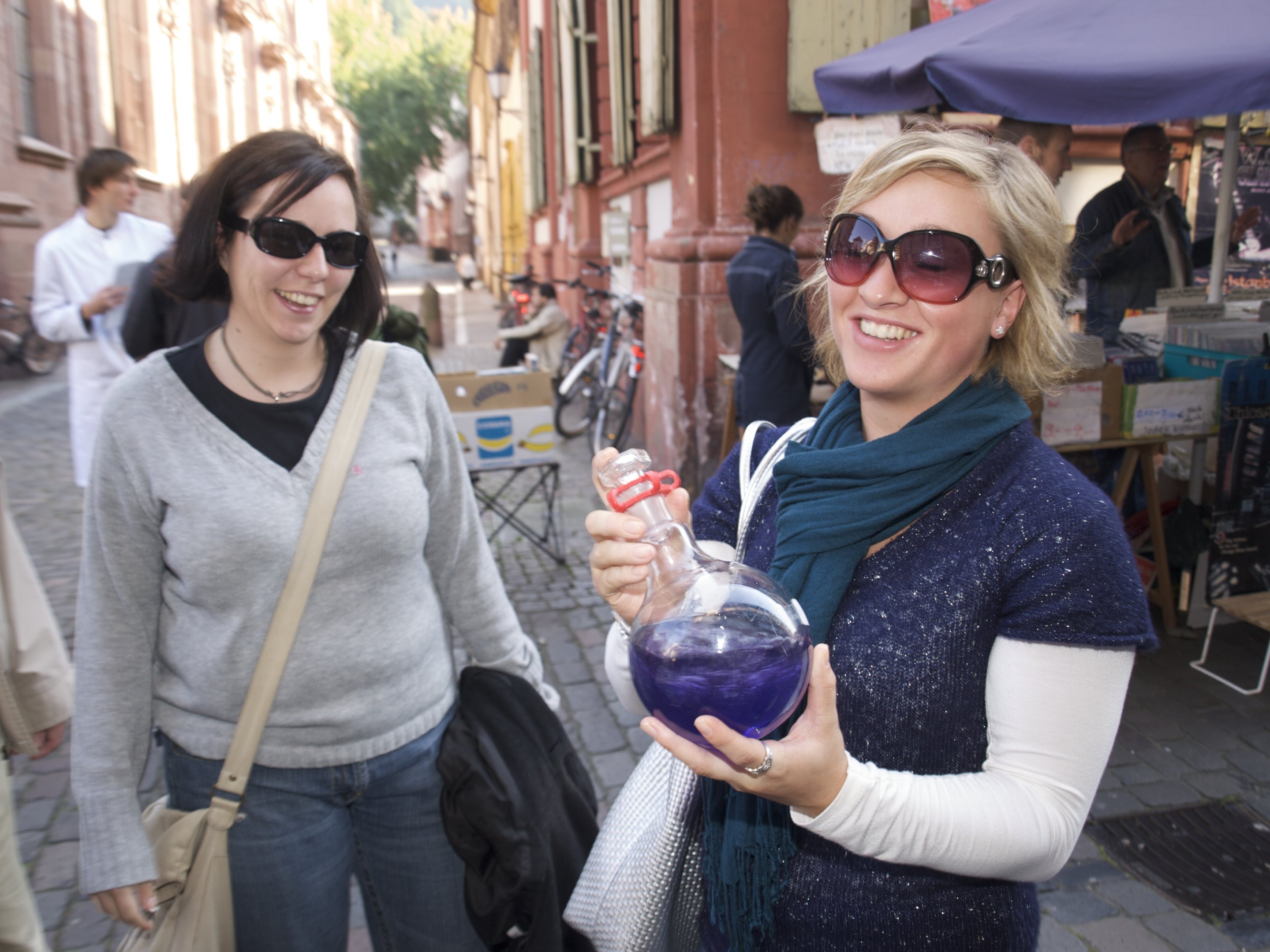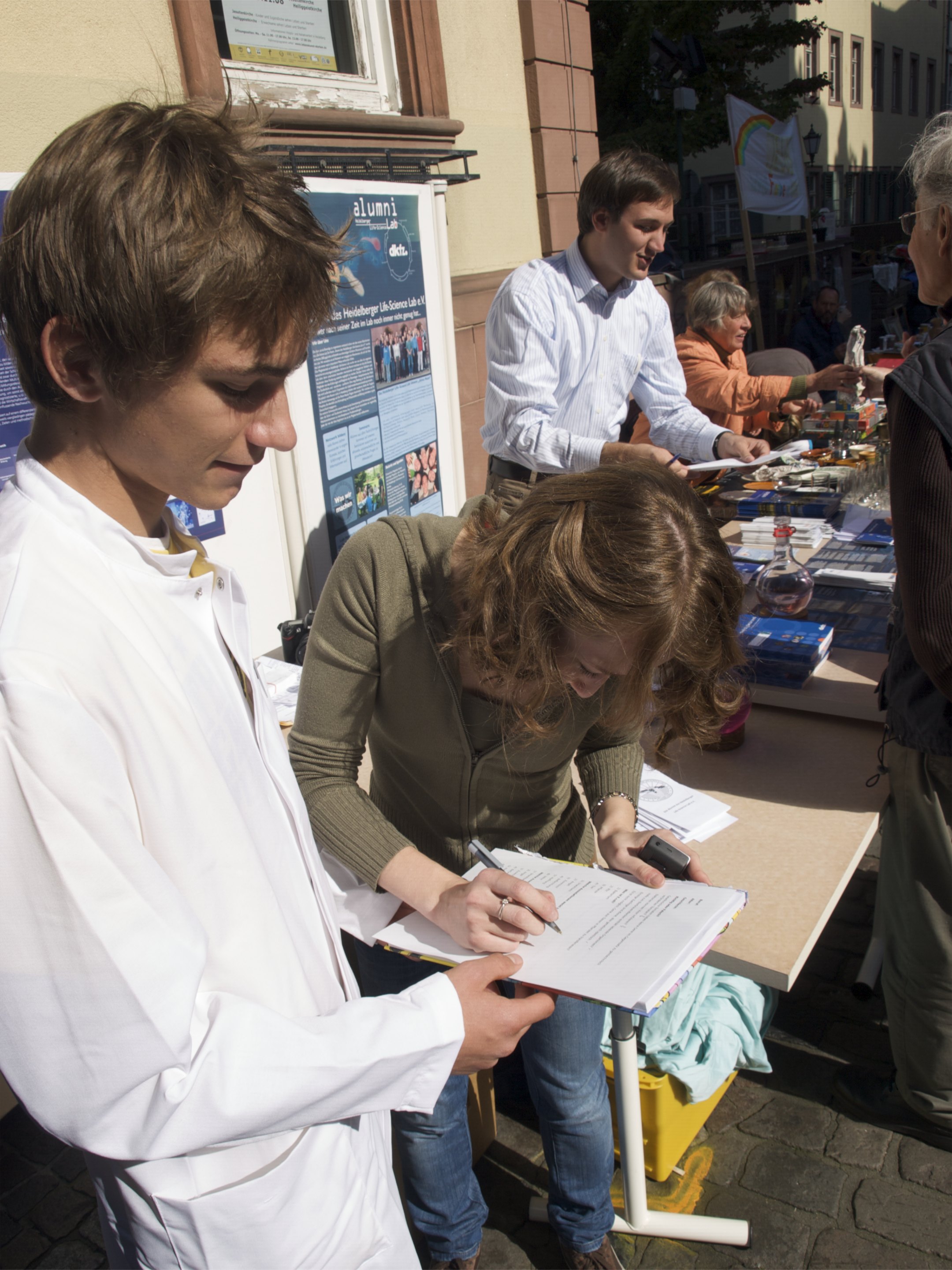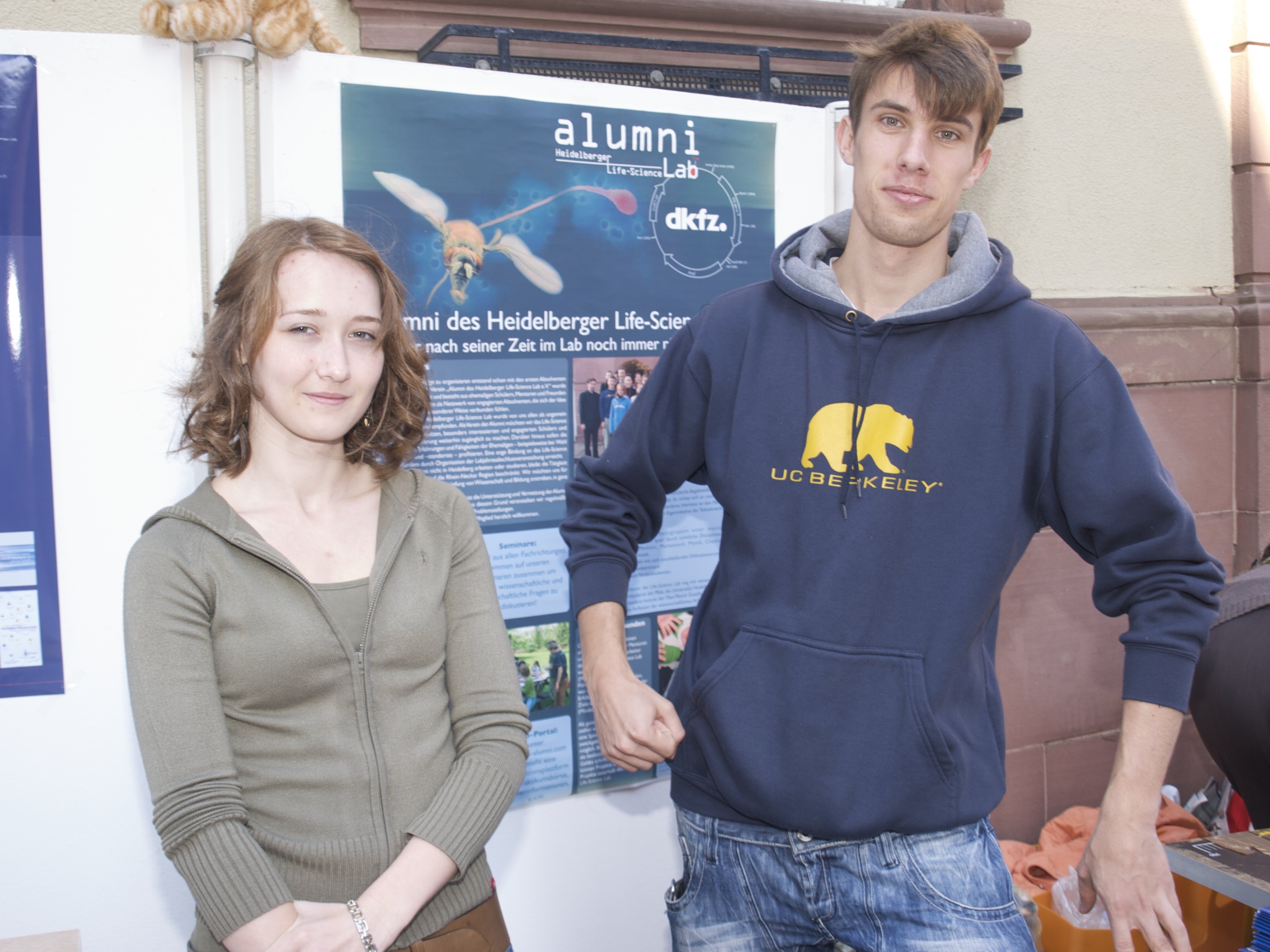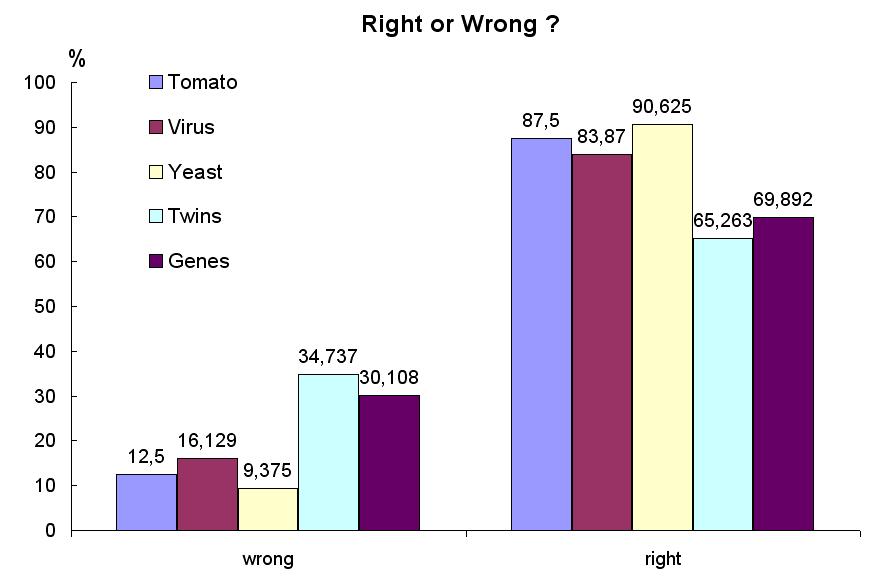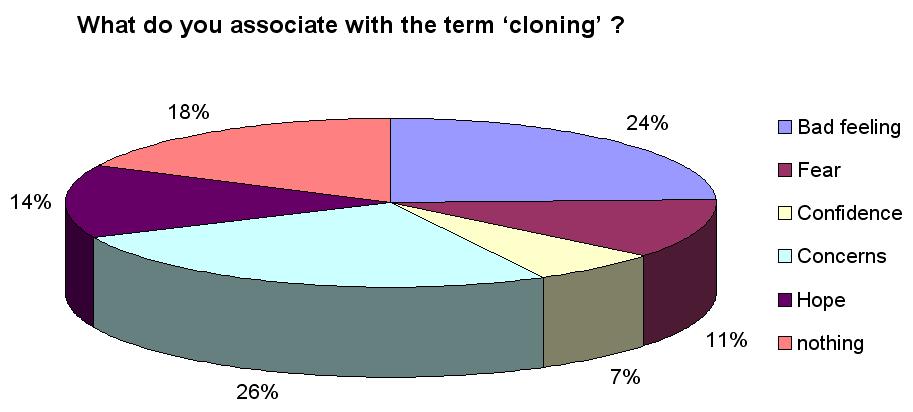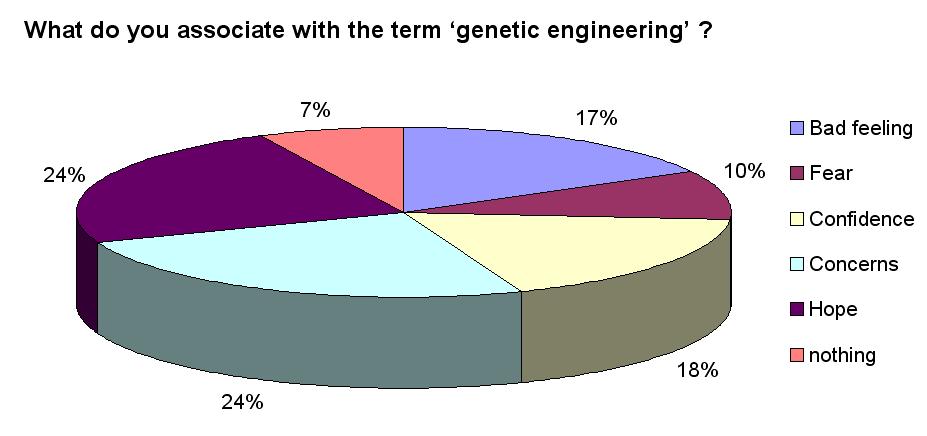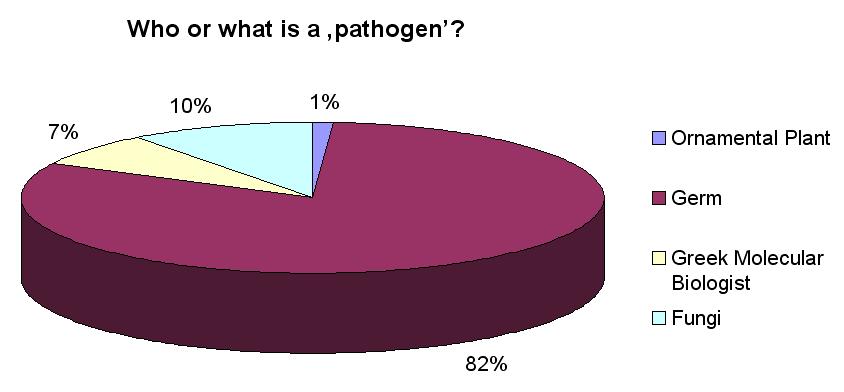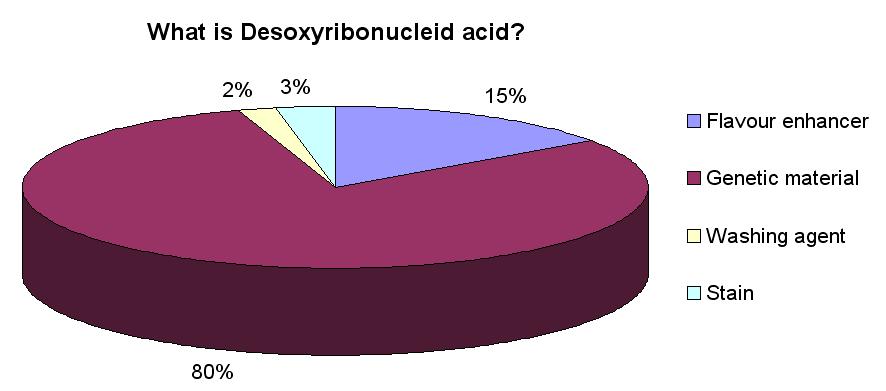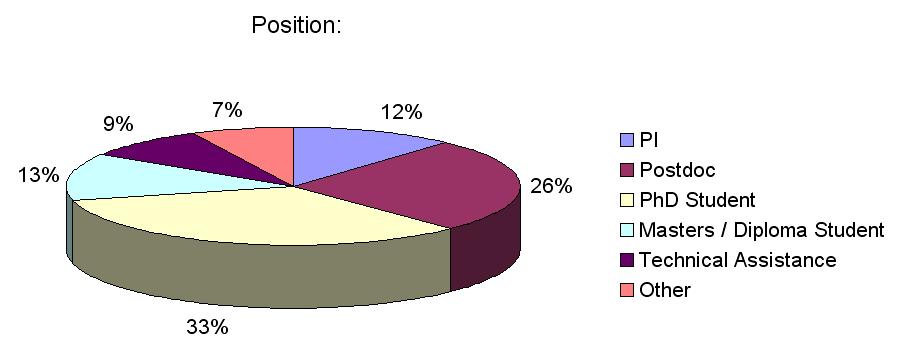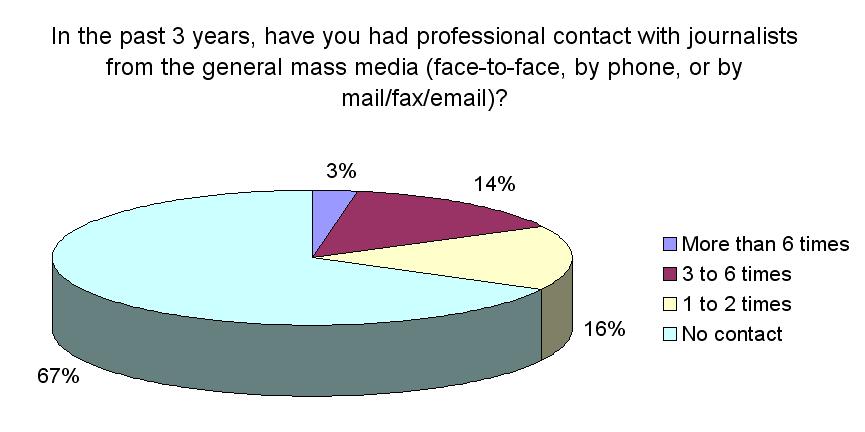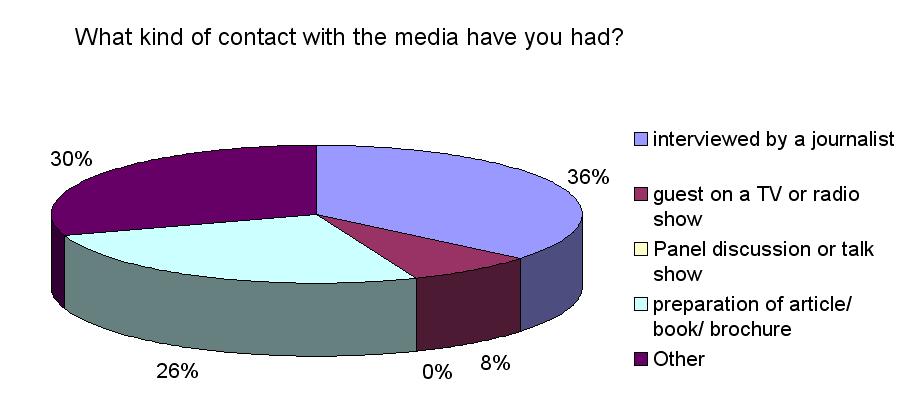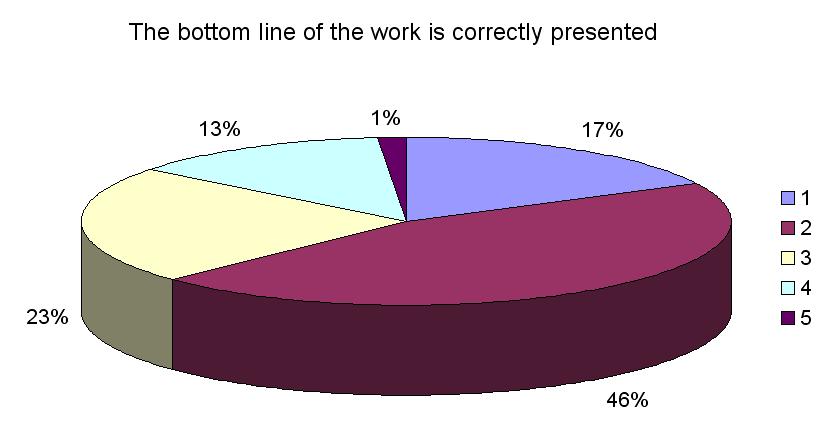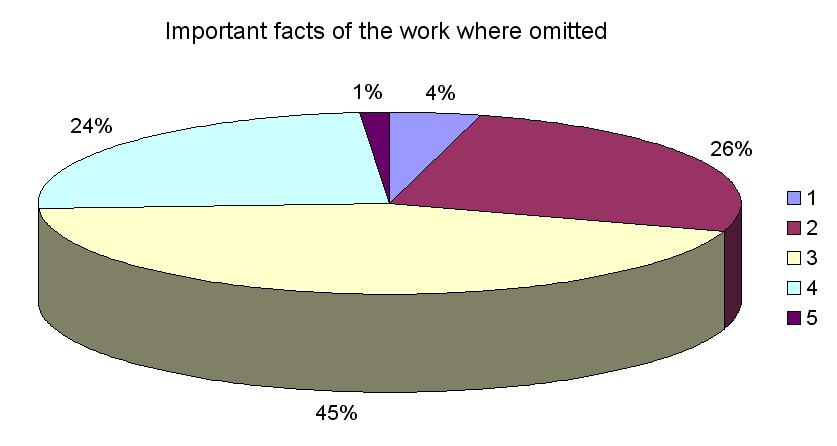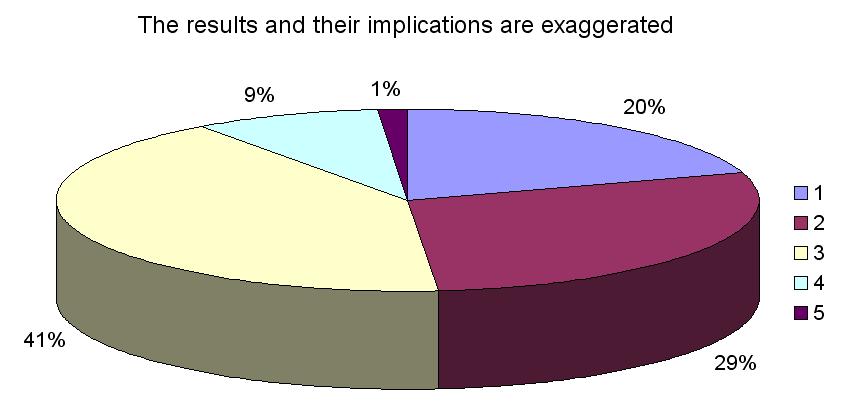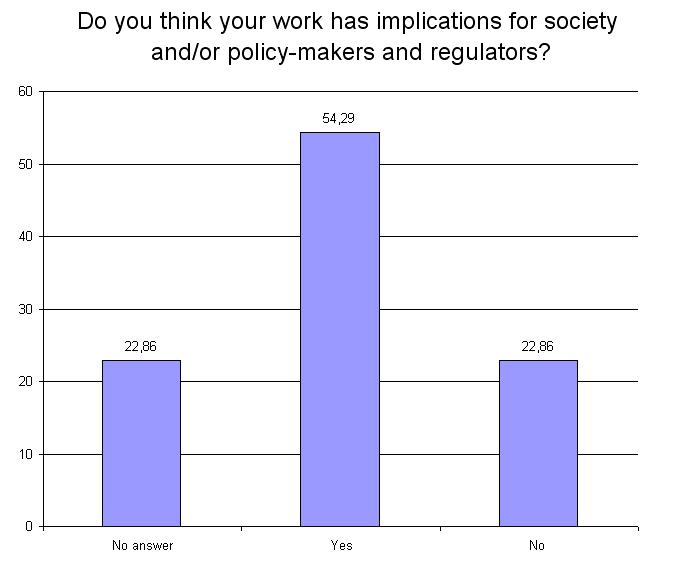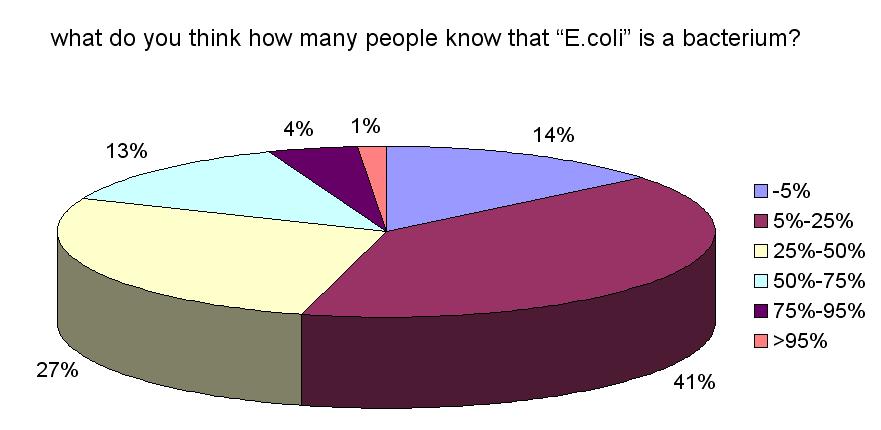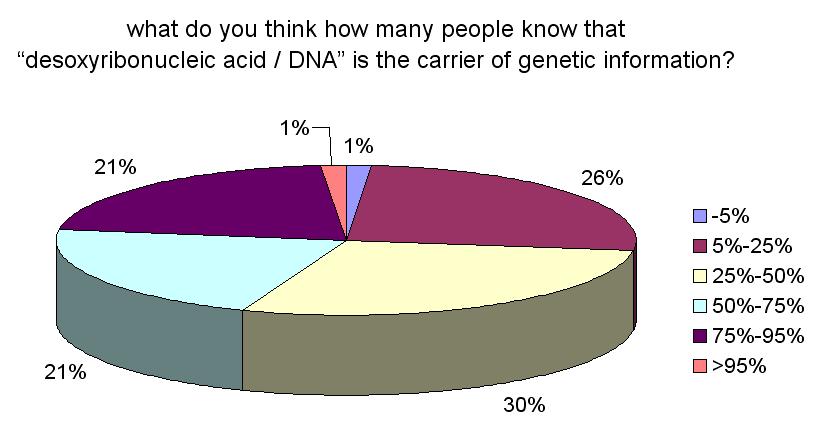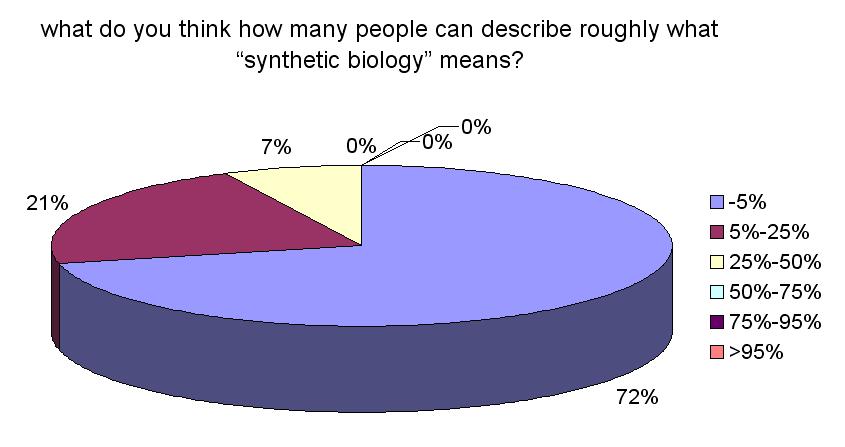Team:Heidelberg/Human Practice/Surveys
From 2008.igem.org
(→Survey-Scientists) |
|||
| (75 intermediate revisions not shown) | |||
| Line 1: | Line 1: | ||
__NOTOC__ | __NOTOC__ | ||
<html> | <html> | ||
| - | <link | + | |
| - | + | ||
| - | + | <style> | |
| + | h1.firstHeading { display: none; } | ||
| + | |||
| + | p {text-align: justify;} | ||
| + | |||
| + | a:link { color: #00b0e6; text-decoration: none} | ||
| + | a:visited { color:#00b0e6; text-decoration: none} | ||
| + | a:hover { color:#f29400; text-decoration: none} | ||
| + | a:active { color:#f29400; text-decoration: none} | ||
| + | |||
| + | #bodyContent { padding: 10px auto; width: 910px; margin: auto; clear: none; } | ||
| + | |||
| + | table#team_members { text-align: justify; border: 0; } | ||
| + | table#team_members h2, table#team_members h3 { clear: both; } | ||
| + | |||
| + | |||
| + | /*-----------------------------------------------------------------------------------------------*/ | ||
| + | div.MenuBar ul li ul.DropDownMenu { | ||
| + | display: none; /* Hides all drop-down menus. */ | ||
| + | |||
| + | } | ||
| + | /* | ||
| + | li:hover works in IE7 and FF2. | ||
| + | a:hover works in IE6 and FF2. | ||
| + | a:hover breaks li:hover in FF2. | ||
| + | */ | ||
| + | div.MenuBar ul li:hover ul.DropDownMenu li ul.SideMenu, | ||
| + | div.MenuBar ul li a:hover ul.DropDownMenu li a ul.SideMenu { | ||
| + | display: none; /* Hides all side menus. */ | ||
| + | } | ||
| + | /*------------------------------------------------------------------------------------- Menu Bar */ | ||
| + | div.MenuBar { | ||
| + | font: arial, helvetica, sans-serif; | ||
| + | height: 30px; | ||
| + | width: 910px; | ||
| + | /*width: 100%*/ | ||
| + | margin: 0; | ||
| + | border-top: 0; | ||
| + | border-right: 0; | ||
| + | border-left: 0; | ||
| + | padding: 0; | ||
| + | background: black; | ||
| + | |||
| + | } | ||
| + | div.MenuBar ul { | ||
| + | font: arial, helvetica, sans-serif; | ||
| + | text-align: center; | ||
| + | list-style-type: none; | ||
| + | margin: 0.5em auto; | ||
| + | border: 0; | ||
| + | padding: 0; | ||
| + | background: black; | ||
| + | } | ||
| + | div.MenuBar ul li { | ||
| + | font: arial, helvetica, sans-serif; | ||
| + | display: block; | ||
| + | padding: 0; | ||
| + | margin: 0; | ||
| + | font-size: 1.3em; | ||
| + | float: left; | ||
| + | background: black; | ||
| + | text-align: center; | ||
| + | width: 107px; | ||
| + | position: relative; /* Sets the positioning context for each drop-down menu. */ | ||
| + | } | ||
| + | |||
| + | div.MenuBar ul li a { | ||
| + | font: arial, helvetica, sans-serif; | ||
| + | display: block; | ||
| + | background: black; | ||
| + | height: 22px; /* Keep height + padding-top + padding-bottom sync with the menu bar height. */ | ||
| + | color: #ffffff; | ||
| + | padding-top: 4px; | ||
| + | padding-bottom: 4px; | ||
| + | padding-left: 1em; /* Sets the left space between top-level items. */ | ||
| + | padding-right: 1em; /* Sets the right space between top-level items. */ | ||
| + | text-decoration: none; | ||
| + | } | ||
| + | |||
| + | /*------------------------------------------------------------------------------ Drop-Down Menus */ | ||
| + | div.MenuBar ul li:hover ul.DropDownMenu, | ||
| + | div.MenuBar ul li a:hover ul.DropDownMenu { | ||
| + | display: block; | ||
| + | width: 10em; /* Drop-down menu width. | ||
| + | Use MenuTailor.css to customize. */ | ||
| + | height: 1em; | ||
| + | padding: 1px; /* Sets the drop-down menu "effective border" width. */ | ||
| + | position: absolute; | ||
| + | top: 23px; /* Places the drop-down menu under the menu bar. | ||
| + | Keep it sync with the menu bar height. */ | ||
| + | left: 0; /* Aligns the drop-down menu to its top-level item. */ | ||
| + | background-color: black; /* Selected item. */ | ||
| + | color: #FFFFFF; | ||
| + | |||
| + | } | ||
| + | div.MenuBar ul li:hover ul.DropDownMenu li a, | ||
| + | div.MenuBar ul li a:hover ul.DropDownMenu li a { | ||
| + | width: 10em; /* Keep it sync with the drop-down menu width. | ||
| + | Use MenuTailor.css to customize. */ | ||
| + | height: 1em; | ||
| + | padding-left: 0; | ||
| + | padding-right: 0; | ||
| + | background-color: black; /* Selected item. */ | ||
| + | color: #FFFFFF; | ||
| + | } | ||
| + | ul.DropDownMenu li a span { | ||
| + | display: block; | ||
| + | padding-left: 0.75em; /* Sets the left space of each drop-down menu item. */ | ||
| + | padding-right: 0.25em; /* Sets the right space of each drop-down menu item. */ | ||
| + | text-align: right; /* Aligns the >> symbol to the right. */ | ||
| + | } | ||
| + | ul.DropDownMenu li a span span { | ||
| + | float: left; /* Aligns the text (back) to the left. */ | ||
| + | font: 12px arial, helvetica, sans-serif; /* Required for IE55. */ | ||
| + | height: 20px; | ||
| + | color: #FFFFFF; | ||
| + | } | ||
| + | /*----------------------------------------------------------------------------------- Side Menus */ | ||
| + | div.MenuBar ul li:hover ul.DropDownMenu li:hover ul.SideMenu, | ||
| + | div.MenuBar ul li a:hover ul.DropDownMenu li a:hover ul.SideMenu { | ||
| + | display: block; | ||
| + | width: 11em; /* Side menu width. | ||
| + | Use MenuTailor.css to customize. */ | ||
| + | padding: 1px; /* Sets the side menu "effective border" width. */ | ||
| + | position: absolute; | ||
| + | top: -1px; /* Aligns the side menu to its drop-down menu item. | ||
| + | Keep it sync with the side menu "effective border" width. */ | ||
| + | left: 13em; /* Places the side menu to the right of the drop-down menu. | ||
| + | Keep it sync with the drop-down menu width. | ||
| + | Use MenuTailor.css to customize. */ | ||
| + | } | ||
| + | div.MenuBar ul li:hover ul.DropDownMenu li:hover ul.SideMenu li a, | ||
| + | div.MenuBar ul li a:hover ul.DropDownMenu li a:hover ul.SideMenu li a { | ||
| + | width: 11em; /* Keep it sync with the side menu width. | ||
| + | Use MenuTailor.css to customize. */ | ||
| + | font: 12px arial, helvetica, sans-serif; /* Required for IE55. */ | ||
| + | left: 13em; /* Places the side menu to the right of the drop-down menu. | ||
| + | Keep it sync with the drop-down menu width. | ||
| + | Use MenuTailor.css to customize. */ | ||
| + | } | ||
| + | div.MenuBar ul li ul.DropDownMenu li ul.SideMenu li a span { | ||
| + | padding-left: 1.5em; /* Sets the left space of each side menu item. */ | ||
| + | padding-right: 0.5em; /* Sets the right space of each side menu item. */ | ||
| + | text-align: left; | ||
| + | font: 12px arial, helvetica, sans-serif; /* Required for IE55. */ | ||
| + | left: 13em; /* Places the side menu to the right of the drop-down menu. | ||
| + | Keep it sync with the drop-down menu width. | ||
| + | Use MenuTailor.css to customize. */ | ||
| + | } | ||
| + | /*----------------------------------------------------------------------------- Browser Specific */ | ||
| + | * html div.MenuBar ul li a { | ||
| + | float: left; /* Required for IE55 and IE6. | ||
| + | Breaks O9. | ||
| + | Hidden (* html) from non-IE browsers. */ | ||
| + | } | ||
| + | * html ul.DropDownMenu li a:hover { | ||
| + | cursor: hand; /* Required for IE55. | ||
| + | Hidden (* html) from non-IE browsers. */ | ||
| + | } | ||
| + | ul.DropDownMenu li a:hover { | ||
| + | cursor: pointer; /* Required for IE6 and IE7. | ||
| + | Hidding it (* html) from non-IE browsers breaks IE7! | ||
| + | } | ||
| + | * html div.MenuBar a:hover { | ||
| + | text-decoration: none; /* Required for IE55 and IE6. | ||
| + | Hidden (* html) from non-IE browsers. */ | ||
| + | } | ||
| + | * html div.MenuBar ul li table, | ||
| + | * html div.MenuBar ul li table td { | ||
| + | border: 0; /* Required for IE55 and IE6. | ||
| + | Hidden (* html) from non-IE browsers. */ | ||
| + | } | ||
| + | /*------------------------------------------------------------------------------- Default Colors */ | ||
| + | div.MenuBar { | ||
| + | background-color: Menu; | ||
| + | border-bottom: 1px solid ButtonShadow; | ||
| + | } | ||
| + | div.MenuBar a { | ||
| + | background-color: Menu; /* Top-level unselected items. */ | ||
| + | color: MenuText; | ||
| + | } | ||
| + | div.MenuBar ul li:hover a, | ||
| + | div.MenuBar ul li a:hover { | ||
| + | color: #ea7f16; | ||
| + | background-color: Highlight; /* Top-level selected item. */ | ||
| + | color: HighlightText; | ||
| + | } | ||
| + | /*...............................................................................................*/ | ||
| + | div.MenuBar ul li:hover ul.DropDownMenu, | ||
| + | div.MenuBar ul li a:hover ul.DropDownMenu { | ||
| + | background-color: ButtonShadow; /* Sets the drop-down menu "effective border" color. */ | ||
| + | } | ||
| + | div.MenuBar ul li:hover ul.DropDownMenu li a, | ||
| + | div.MenuBar ul li a:hover ul.DropDownMenu li a { | ||
| + | background-color: Menu; Drop-down menu unselected items. | ||
| + | Sets the drop-down menu "effective background" color. */ | ||
| + | color: MenuText; | ||
| + | } | ||
| + | div.MenuBar ul li:hover ul.DropDownMenu li:hover a, | ||
| + | div.MenuBar ul li a:hover ul.DropDownMenu li a:hover { | ||
| + | background-color: Highlight; /* Drop-down menu selected item. */ | ||
| + | color: HighlightText; | ||
| + | } | ||
| + | /*...............................................................................................*/ | ||
| + | div.MenuBar ul li:hover ul.DropDownMenu li:hover ul.SideMenu, | ||
| + | div.MenuBar ul li a:hover ul.DropDownMenu li a:hover ul.SideMenu { | ||
| + | background-color: ButtonShadow; /* Sets the side menu "effective border" color. */ | ||
| + | } | ||
| + | div.MenuBar ul li:hover ul.DropDownMenu li:hover ul.SideMenu li a, | ||
| + | div.MenuBar ul li a:hover ul.DropDownMenu li a:hover ul.SideMenu li a { | ||
| + | background-color: Menu; /* Side menu unselected items. | ||
| + | Sets the side menu "effective background" color. */ | ||
| + | color: MenuText; | ||
| + | } | ||
| + | div.MenuBar ul li:hover ul.DropDownMenu li:hover ul.SideMenu li a:hover, | ||
| + | div.MenuBar ul li a:hover ul.DropDownMenu li a:hover ul.SideMenu li a:hover { | ||
| + | background-color: Highlight; /* Side menu selected item. */ | ||
| + | color: HighlightText; | ||
| + | } | ||
| + | /*-----------------------------------------------------------------------------------------------*/ | ||
| + | /*Script-Free 3-Level Menu 1.2 Tailor | ||
| + | www.CesarDaniel.info | ||
| + | /*-------------------------------------------------------------------------------------- General */ | ||
| + | body { | ||
| + | background: white; | ||
| + | color: black; | ||
| + | margin: 0; | ||
| + | border: 0; | ||
| + | padding: 0; | ||
| + | } | ||
| + | |||
| + | |||
| + | div.MenuBar { | ||
| + | font: 13px arial, helvetica, sans-serif; | ||
| + | } | ||
| + | div.MenuBar ul { | ||
| + | font: 13px arial, helvetica, sans-serif; /* Required for IE55. */ | ||
| + | } | ||
| + | /*--------------------------------------------------------------------------------------- Colors */ | ||
| + | div.MenuBar { | ||
| + | background-color: black; /* Selected item. */ | ||
| + | color: #FFFFFF; | ||
| + | border-bottom: 1px solid ButtonShadow; | ||
| + | } | ||
| + | div.MenuBar a, | ||
| + | div.MenuBar ul li:hover ul.DropDownMenu li a, | ||
| + | div.MenuBar ul li a:hover ul.DropDownMenu li a, | ||
| + | div.MenuBar ul li:hover ul.DropDownMenu li:hover ul.SideMenu li a, | ||
| + | div.MenuBar ul li a:hover ul.DropDownMenu li a:hover ul.SideMenu li a { | ||
| + | background-color: black; /* Selected item. */ | ||
| + | color: #FFFFFF; | ||
| + | } | ||
| + | div.MenuBar ul li:hover a, | ||
| + | div.MenuBar ul li a:hover, | ||
| + | div.MenuBar ul li:hover ul.DropDownMenu li:hover a, | ||
| + | div.MenuBar ul li a:hover ul.DropDownMenu li a:hover, | ||
| + | div.MenuBar ul li:hover ul.DropDownMenu li:hover ul.SideMenu li a:hover, | ||
| + | div.MenuBar ul li a:hover ul.DropDownMenu li a:hover ul.SideMenu li a:hover { | ||
| + | background-color: #00b0e6; /* Selected item. */ | ||
| + | color: #FFFFFF; | ||
| + | } | ||
| + | div.MenuBar ul li:hover ul.DropDownMenu, | ||
| + | div.MenuBar ul li a:hover ul.DropDownMenu, | ||
| + | div.MenuBar ul li:hover ul.DropDownMenu li:hover ul.SideMenu, | ||
| + | div.MenuBar ul li a:hover ul.DropDownMenu li a:hover ul.SideMenu { | ||
| + | background-color: ButtonShadow; /* Sets the drop-down and side menus "effective border" color. */ | ||
| + | } | ||
| + | /*--------------------------------------------------------------------------------------- Widths */ | ||
| + | /* | ||
| + | |||
| + | /* | ||
| + | Menu Bar 1 | ||
| + | Drop-Down Menu #2 | ||
| + | */ | ||
| + | div.MenuBar#navi ul li:hover ul.DropDownMenu#MB1-DDM4, | ||
| + | div.MenuBar#navi ul li a:hover ul.DropDownMenu#MB1-DDM4, | ||
| + | div.MenuBar#navi ul li:hover ul.DropDownMenu#MB1-DDM4 li a, | ||
| + | div.MenuBar#navi ul li a:hover ul.DropDownMenu#MB1-DDM4 li a { | ||
| + | width: 11em; /* Drop-down menu width. */ | ||
| + | } | ||
| + | div.MenuBar#navi ul li:hover ul.DropDownMenu#MB1-DDM5, | ||
| + | div.MenuBar#navi ul li a:hover ul.DropDownMenu#MB1-DDM5, | ||
| + | div.MenuBar#navi ul li:hover ul.DropDownMenu#MB1-DDM5 li a, | ||
| + | div.MenuBar#navi ul li a:hover ul.DropDownMenu#MB1-DDM5 li a { | ||
| + | width: 12em; /* Drop-down menu width. */ | ||
| + | } | ||
| + | |||
| + | /*...............................................................................................*/ | ||
| + | /* | ||
| + | Menu Bar 1 | ||
| + | Drop-Down Menu #2 | ||
| + | Side Menu #1 | ||
| + | */ | ||
| + | div.MenuBar#navi ul li:hover ul.DropDownMenu li:hover ul.SideMenu#MB1-DDM2-SM1, | ||
| + | div.MenuBar#navi ul li a:hover ul.DropDownMenu li a:hover ul.SideMenu#MB1-DDM2-SM1 { | ||
| + | left: 15.5em !important; /* Places the side menu to the right of the drop-down menu. | ||
| + | Keep it sync with the drop-down menu width. */ | ||
| + | } | ||
| + | div.MenuBar#navi ul li:hover ul.DropDownMenu li:hover ul.SideMenu#MB1-DDM2-SM1, | ||
| + | div.MenuBar#navi ul li a:hover ul.DropDownMenu li a:hover ul.SideMenu#MB1-DDM2-SM1, | ||
| + | div.MenuBar#navi ul li:hover ul.DropDownMenu li:hover ul.SideMenu#MB1-DDM2-SM1 li a, | ||
| + | div.MenuBar#navi ul li a:hover ul.DropDownMenu li a:hover ul.SideMenu#MB1-DDM2-SM1 li a { | ||
| + | width: 10em; /* Side menu width. */ | ||
| + | } | ||
| + | /*...............................................................................................*/ | ||
| + | /* | ||
| + | Menu Bar 1 | ||
| + | Drop-Down Menu #2 | ||
| + | Side Menu #2 | ||
| + | */ | ||
| + | div.MenuBar#navi ul li:hover ul.DropDownMenu li:hover ul.SideMenu#MB1-DDM2-SM2, | ||
| + | div.MenuBar#navi ul li a:hover ul.DropDownMenu li a:hover ul.SideMenu#MB1-DDM2-SM2 { | ||
| + | left: 15.5em !important; /* Places the side menu to the right of the drop-down menu. | ||
| + | Keep it sync with the drop-down menu width. */ | ||
| + | } | ||
| + | div.MenuBar#navi ul li:hover ul.DropDownMenu li:hover ul.SideMenu#MB1-DDM2-SM2, | ||
| + | div.MenuBar#navi ul li a:hover ul.DropDownMenu li a:hover ul.SideMenu#MB1-DDM2-SM2, | ||
| + | div.MenuBar#navi ul li:hover ul.DropDownMenu li:hover ul.SideMenu#MB1-DDM2-SM2 li a, | ||
| + | div.MenuBar#navi ul li a:hover ul.DropDownMenu li a:hover ul.SideMenu#MB1-DDM2-SM2 li a { | ||
| + | width: 10em; /* Side menu width. */ | ||
| + | } | ||
| + | /*...............................................................................................*/ | ||
| + | /* | ||
| + | Menu Bar 1 | ||
| + | Drop-Down Menu #2 | ||
| + | Side Menu #3 | ||
| + | */ | ||
| + | div.MenuBar#navi ul li:hover ul.DropDownMenu li:hover ul.SideMenu#MB1-DDM2-SM3, | ||
| + | div.MenuBar#navi ul li a:hover ul.DropDownMenu li a:hover ul.SideMenu#MB1-DDM2-SM3 { | ||
| + | left: 15.5em !important; /* Places the side menu to the right of the drop-down menu. | ||
| + | Keep it sync with the drop-down menu width. */ | ||
| + | } | ||
| + | div.MenuBar#navi ul li:hover ul.DropDownMenu li:hover ul.SideMenu#MB1-DDM2-SM3, | ||
| + | div.MenuBar#navi ul li a:hover ul.DropDownMenu li a:hover ul.SideMenu#MB1-DDM2-SM3, | ||
| + | div.MenuBar#navi ul li:hover ul.DropDownMenu li:hover ul.SideMenu#MB1-DDM2-SM3 li a, | ||
| + | div.MenuBar#navi ul li a:hover ul.DropDownMenu li a:hover ul.SideMenu#MB1-DDM2-SM3 li a { | ||
| + | width: 10em; /* Side menu width. */ | ||
| + | } | ||
| + | /*...............................................................................................*/ | ||
| + | |||
| + | </style> | ||
| + | |||
<body> | <body> | ||
| Line 123: | Line 464: | ||
</html> | </html> | ||
| - | == | + | {| |
| + | | | ||
| + | =='''Survey-Public'''== | ||
| - | + | On the 27th of September we carried out an information- and survey day in the pedestrian area of Heidelberg and asked 100 randomly picked people the following questions. The questionnaire of the survey is partly based on the evaluations of the European Union on Biotechnology [[Team:Heidelberg/Project/Science_Communication/Survey_public#References|[1]]], expanded and adapted for our purposes. | |
| - | + | ||
| - | + | ||
| - | + | ||
| - | + | ||
| - | + | By the help of this survey we wanted to get a feeling for how much the public knows, generally about biology and biotechnology and about synthetic biology. To really get a quite representative answer, we decided to carry out the survey in the pedestrian area of Heidelberg, because we wanted to prevent asking only a certain audience when interviewing friends and family. The results of the survey should help us to decide on which level we should write the background information in the wiki and in the information brochure, so everybody can really understand it. To get some impressions about our information and survey day klick here on the [[Team:Heidelberg/Human_Practice/Survey/Gallery| '''Photogallery: Info and Survey Day''']]. | |
| - | + | ||
| - | + | ||
| - | + | ||
| - | + | ||
| - | + | ||
| - | + | ||
| - | + | ||
| - | + | ||
| - | + | ||
| - | + | ||
| - | + | ||
| - | + | ||
| - | + | ||
| - | + | ||
| - | + | ||
| - | + | ||
| - | + | ||
| - | + | ||
| - | + | ||
| - | + | ||
| - | + | ||
| - | + | ||
| - | + | ||
| - | + | ||
| - | + | ||
| - | + | ||
| - | + | ||
| - | + | ||
| - | + | ||
| - | + | ||
| - | + | ||
| - | + | ||
| - | + | ||
| - | + | ||
| - | + | ||
| - | + | ||
| - | + | ||
| - | + | ||
| - | + | ||
| - | + | ||
| - | + | ||
| - | + | ||
| - | + | ||
| - | + | ||
| - | + | ||
| - | + | ||
| - | + | ||
| - | + | ||
| - | + | ||
| - | + | ||
| - | + | ||
| - | + | ||
| - | + | ||
| - | + | ||
| - | + | ||
| - | + | ||
| - | + | ||
| - | + | ||
| - | + | ||
| - | + | ||
| - | + | ||
| - | + | ||
| - | + | ||
| - | + | ||
| - | + | ||
| - | + | ||
| - | + | ||
| - | + | ||
| - | + | ||
| - | + | ||
| - | + | ||
| - | + | ||
| - | + | ||
| - | + | ||
| - | + | ||
| - | + | ||
| - | + | ||
| - | + | ||
| - | + | ||
| - | + | ||
| - | + | ||
| - | + | ||
| - | + | ||
| - | + | ||
| - | + | ||
| - | + | ||
| - | + | ||
| - | + | ||
| - | + | ||
| - | + | ||
| - | + | ||
| - | + | ||
| - | + | ||
| - | + | ||
| - | + | ||
| - | + | ||
| - | + | ||
| - | + | ||
| - | + | ||
| - | + | ||
| - | + | ||
| - | + | ||
| - | + | ||
| - | + | ||
| - | + | ||
| - | + | ||
| - | + | ||
| - | + | ||
| - | + | ||
| - | + | ||
| - | + | ||
| - | + | ||
| - | + | ||
| - | + | ||
| - | + | ||
{|id="team_members" | {|id="team_members" | ||
| Line 377: | Line 601: | ||
6) Yes, on the radio<br> | 6) Yes, on the radio<br> | ||
7) Yes, but I do not remember where<br> | 7) Yes, but I do not remember where<br> | ||
| - | |||
'''If yes, do you remember the topic?<br>''' | '''If yes, do you remember the topic?<br>''' | ||
| - | + | [[https://2008.igem.org/Team:Heidelberg/Human_Practice/Surveys back]] | |
| + | |[[Image:surhd15.jpg|right|230 px]] | ||
| + | <br> | ||
| + | [[Image:surhd7.jpg|right|230px]] | ||
| + | <br> | ||
| + | [[Image:surhd18.jpg|right|230 px]] | ||
| + | <br> | ||
| + | [[Image:surhd13.jpg|right|230 px]] | ||
| + | <br> | ||
| + | [[Image:surhd19.jpg|right|230 px]] | ||
| + | <br> | ||
| + | [[Image:surhd10.jpg|right|230 px]] | ||
| + | <br> | ||
|} | |} | ||
== '''Results''' == | == '''Results''' == | ||
| - | [[Image:S_Gender.JPG|left|400px]] | + | {| class="wikitable" |
| - | [[Image:S_Right_wrong.JPG|right|450px]] | + | |[[Image:S_Gender.JPG|left|400px]] [[Image:S_Right_wrong.JPG|right|450px]] |
| + | |- | ||
| + | |[[Image:S_Ecoli.JPG|left|375px]] [[Image:S_Cloning.JPG|right|425px]] | ||
| + | |- | ||
| + | |[[Image:Genetic_engineering.JPG|left|425px]] [[Image:S_Pathogen.JPG|right|450px]] | ||
| + | |- | ||
| + | |[[Image:S_DNA.JPG|left|425px]] [[Image:S_Media.JPG|right|450px]] | ||
| + | |} | ||
| + | == '''Conclusions''' == | ||
| - | + | Our results show that the public in Heidelberg is quite well informed about the most basic background of biology and biotechnology. For example, 87,5% knew that ordinary tomatoes have genes (and not only genetically engineered ones). Only 50% of the European citizens answer this question right. | |
| - | + | ||
| + | What we also can say is that the Heidelbergers still are quite sceptical towards biotechnology in general. Two thirds of the interviewed answered that they associate concerns or fear with the term genetic engineering (‘Gentechnik’). Only one fifth had positive associations like hope and confidence. | ||
| - | + | Unsurprisingly, '''only very few people - 5,2% - have already heard of 'synthetic biology' or can correctly describe what it means'''. | |
| - | + | ||
| + | What really matters for us is that 83% of the surveyed people answer that they had tracked reports about biotechnology in the media. That means there is an interested public, everything we need to do is provide information for them they can understand and enjoy learning from. We also can see that the use of media is quite balancedly spread: Newspapers, the internet, magazines and television are all frequented from 15-20% of the people. Only the radio is not as often used. This means for us, we have to use different media to communicate. | ||
| - | + | == '''References''' == | |
| - | + | ||
| + | [1] Europeans and Biotechnology in 2005:Patterns and Trends, Ref. 244b , Wave EB64.3, http://ec.europa.eu/public_opinion/archives/eb_special_en.htm | ||
| + | <br/> | ||
| + | <br/> | ||
| + | == '''Survey-Scientists ''' == | ||
| + | From the 23rd to the 24th of October we have carried out an online survey questioning 300 scientists of the Bioquant in Heidelberg to answer the following questions. The questionnaire of the survey is based on several studies [[Team:Heidelberg/Project/Science_Communication/Survey_scientists#References|[1]]],[[Team:Heidelberg/Project/Science_Communication/Survey_scientists#References|[2]]], expanded and adapted for our purposes. | ||
| + | '''Field of research:''' | ||
| - | . | + | - Synthetic Biology<br> |
| + | - Systems Biology<br> | ||
| + | - Molecular Biology<br> | ||
| + | - Cell Biology<br> | ||
| + | - Translational Research<br> | ||
| + | - Clinical Research<br> | ||
| + | - Other: please specify<br> | ||
| + | |||
| + | '''Position:''' | ||
| + | |||
| + | - PI<br> | ||
| + | - Postdoc<br> | ||
| + | - PhD Student<br> | ||
| + | - Masters / Diploma Student<br> | ||
| + | - Technical Assistance<br> | ||
| + | - Other please specifiy<br> | ||
| + | |||
| + | '''1. In the past 3 years, have you had professional contact with journalists from the general mass media (face-to-face, by phone, or by mail/fax/email)?''' | ||
| + | |||
| + | a. More than 6 times<br> | ||
| + | b. 2 to 6 times<br> | ||
| + | c. 1 to 2 times<br> | ||
| + | d. No contact<br> | ||
| + | |||
| + | '''2. What kind of contact with the media have you had? (Check all alternatives that apply.)''' | ||
| + | |||
| + | a. Been interviewed by a journalist<br> | ||
| + | b. Been a guest on a TV or radio <br> | ||
| + | c. Panel discussion or talk show provided background information for a popular article or program in the media<br> | ||
| + | d. Participated in preparation of article / book / brochure addressed to general audience<br> | ||
| + | e. Other, please specify<br> | ||
| + | |||
| + | '''3. Judging reports about your field of work in press articles or other reports in other media, how do you think the science facts are represented: (1-5 accurate - bad)''' | ||
| + | |||
| + | a. The bottom line of the work is correctly presented.<br> | ||
| + | b. Important facts of the work where omitted thereby hindering comprehension of the science behind<br> | ||
| + | c. The results and their implications are exaggerated<br> | ||
| + | |||
| + | '''4. Do you think your work has implications for society and/or policy-makers and regulators?''' | ||
| + | |||
| + | a. Yes<br> | ||
| + | b. No<br> | ||
| + | c. Don’t know / not sure<br> | ||
| + | |||
| + | |||
| + | '''When carrying out a survey in the pedestrian area of Heidelberg,''' | ||
| + | |||
| + | '''5. what do you think how many people know that “E.coli” is a bacterium?''' | ||
| + | |||
| + | a. -5%<br> | ||
| + | b. 5%-25%<br> | ||
| + | c. 25%-50%<br> | ||
| + | d. 50%-75%<br> | ||
| + | e. 75%-95%<br> | ||
| + | f. > 95%<br> | ||
| + | |||
| + | '''6. what do you think how many people know what a “pathogen” is?''' | ||
| + | |||
| + | a. -5%<br> | ||
| + | b. 5%-25%<br> | ||
| + | c. 25%-50%<br> | ||
| + | d. 50%-75%<br> | ||
| + | e. 75%-95%<br> | ||
| + | f. > 95%<br> | ||
| + | |||
| + | '''7. what do you think how many people know that “desoxyribonucleic acid / DNA” is the carrier of genetic information?''' | ||
| + | |||
| + | a. -5%<br> | ||
| + | b. 5%-25%<br> | ||
| + | c. 25%-50%<br> | ||
| + | d. 50%-75%<br> | ||
| + | e. 75%-95%<br> | ||
| + | f. > 95%<br> | ||
| + | |||
| + | '''8. what do you think how many people can describe roughly what “synthetic biology” means?''' | ||
| + | |||
| + | a. -5%<br> | ||
| + | b. 5%-25%<br> | ||
| + | c. 25%-50%<br> | ||
| + | d. 50%-75%<br> | ||
| + | e. 75%-95%<br> | ||
| + | f. > 95%<br> | ||
| + | [[https://2008.igem.org/Team:Heidelberg/Human_Practice/Surveys back]] | ||
| + | |||
| + | == '''Results''' == | ||
| + | |||
| + | |||
| + | {| class="wikitable" | ||
| + | |[[Image:Position.JPG|left|425px]][[Image:Field_research.JPG|right|450px]] | ||
| + | |- | ||
| + | |[[Image:Contact_times.JPG|left|425px]][[Image:Media_contact.JPG|right|425px]]<br> | ||
| + | |- | ||
| + | |'''Judging reports about your field of work in press articles or other reports in other media, how do you think the science facts are represented:'''<br> | ||
| + | |- | ||
| + | |[[Image:S_Correct.JPG|left|425px]][[Image:Facts_omitted.JPG|right|450px]] | ||
| + | |- | ||
| + | |[[Image:Results_exxageraed.JPG|left|425px]][[Image:Implications.JPG|right|425px]]<br> | ||
| + | |- | ||
| + | |'''When carrying out a survey in the pedestrian area of Heidelberg,'''<br> | ||
| + | |- | ||
| + | |[[Image:Ss_ecoli.JPG|left|425px]][[Image:Ss_dna.JPG|right|425px]] | ||
| + | |- | ||
| + | |[[Image:Ss_pathogen.JPG|left|425px]][[Image:Ssynbio.JPG|right|425px]] | ||
| + | |} | ||
| + | |||
| + | == '''Conclusions''' == | ||
| + | |||
| + | The first thing to say is that only one third of the questioned scientists had contact with the media in the past years. This means, there is a big potential of people to encourage for science communication! | ||
| + | |||
| + | 26% of the scientists have already written an article or book for the non-scientistic public - which means they were clearly engaged in popularizing their work. | ||
| + | |||
| + | The questions about the experience with reports by the media about scientist's work show, that the point of view of scientists towards the media is not entirely positive: Still, two thirds think that the bottom line of their work is presented correctly. But one third also opines that important facts where omitted. This is a very important conflict point between scientists and journalists: Journalists have to omit facts and details, to write a fascinating story, which many people will read. But most scientists would prefer their work to be presented completely - some details may be very important to them. | ||
| + | |||
| + | This is also a thing we experienced in the context of this project: There definitely were facts omitted in reports about our work. And when we read the reports for the first time, some of us were quite unhappy. Others were even shocked about what the journalists did with what they told them about our work. But you have to take into consideration, that the details and special facts do not matter to somebody, who has never heard of your project before and whom you want to interest for your research (and not give a lecture on the details). So as long as the bottom line is presented correctly, and there are no massive mistakes in the presentation of your work, we think to accept this lack of details is a fair thing to do to enable science communication. | ||
| + | |||
| + | This leads us to the next point: Nearly half the questioned scientists think that their work is exaggerted in media reports. Some may find this good (because it may help acquire sponsors), others may think it's bad because it is not realistic, but this is also one thing we have to accept (if it is not too extreme), in our opinion. Because the people working in media live from the audience bying their newpapers and watching their TV shows. So they have to arouse interest. And this can be done by exaggerating. And to be honest - is there anything in the media that is not presented a little bit in an exaggerted way? | ||
| + | |||
| + | Another important point for us to know was if scientists are aware of the fact that their work may have impact on policy makers and on the public. And we can clearly answer this question with yes. | ||
| + | |||
| + | After we have investigated the level of knowledge of the public, it was important for us to see how scientists asses it. And surprisingly, we can see a great discrepancy between the knowledge and the assessment. The public is much better informed than most scientists think. This is a very important finding, because the more the public knows, the shorter the distance is, scientists have to go to fetch the public at their point of knowledge, when they tell about their work. Maybe if scientists imagine this distance to be very long, they are not motivated to go this way. So this result is very positive and should motivate more to think about communicating science. [[https://2008.igem.org/Team:Heidelberg/Human_Practice/Surveys back]] | ||
== '''References''' == | == '''References''' == | ||
| - | [1] | + | [1] Science Communication, Interactions with the Mass Media, Science,Vol. 321. no. 5886, pp. 204 – 205, July 2008 |
| + | |||
| + | [2] Science Communication, Report of the Royal Society, June 2006, http://royalsociety.org/page.asp?id=3180 | ||
Latest revision as of 16:01, 29 October 2008


Survey-PublicOn the 27th of September we carried out an information- and survey day in the pedestrian area of Heidelberg and asked 100 randomly picked people the following questions. The questionnaire of the survey is partly based on the evaluations of the European Union on Biotechnology [1], expanded and adapted for our purposes. By the help of this survey we wanted to get a feeling for how much the public knows, generally about biology and biotechnology and about synthetic biology. To really get a quite representative answer, we decided to carry out the survey in the pedestrian area of Heidelberg, because we wanted to prevent asking only a certain audience when interviewing friends and family. The results of the survey should help us to decide on which level we should write the background information in the wiki and in the information brochure, so everybody can really understand it. To get some impressions about our information and survey day klick here on the Photogallery: Info and Survey Day.
ResultsConclusionsOur results show that the public in Heidelberg is quite well informed about the most basic background of biology and biotechnology. For example, 87,5% knew that ordinary tomatoes have genes (and not only genetically engineered ones). Only 50% of the European citizens answer this question right. What we also can say is that the Heidelbergers still are quite sceptical towards biotechnology in general. Two thirds of the interviewed answered that they associate concerns or fear with the term genetic engineering (‘Gentechnik’). Only one fifth had positive associations like hope and confidence. Unsurprisingly, only very few people - 5,2% - have already heard of 'synthetic biology' or can correctly describe what it means. What really matters for us is that 83% of the surveyed people answer that they had tracked reports about biotechnology in the media. That means there is an interested public, everything we need to do is provide information for them they can understand and enjoy learning from. We also can see that the use of media is quite balancedly spread: Newspapers, the internet, magazines and television are all frequented from 15-20% of the people. Only the radio is not as often used. This means for us, we have to use different media to communicate. References[1] Europeans and Biotechnology in 2005:Patterns and Trends, Ref. 244b , Wave EB64.3, http://ec.europa.eu/public_opinion/archives/eb_special_en.htm
Survey-ScientistsFrom the 23rd to the 24th of October we have carried out an online survey questioning 300 scientists of the Bioquant in Heidelberg to answer the following questions. The questionnaire of the survey is based on several studies [1],[2], expanded and adapted for our purposes. Field of research: - Synthetic Biology Position: - PI 1. In the past 3 years, have you had professional contact with journalists from the general mass media (face-to-face, by phone, or by mail/fax/email)? a. More than 6 times 2. What kind of contact with the media have you had? (Check all alternatives that apply.) a. Been interviewed by a journalist 3. Judging reports about your field of work in press articles or other reports in other media, how do you think the science facts are represented: (1-5 accurate - bad) a. The bottom line of the work is correctly presented. 4. Do you think your work has implications for society and/or policy-makers and regulators? a. Yes
5. what do you think how many people know that “E.coli” is a bacterium? a. -5% 6. what do you think how many people know what a “pathogen” is? a. -5% 7. what do you think how many people know that “desoxyribonucleic acid / DNA” is the carrier of genetic information? a. -5% 8. what do you think how many people can describe roughly what “synthetic biology” means? a. -5% Results
ConclusionsThe first thing to say is that only one third of the questioned scientists had contact with the media in the past years. This means, there is a big potential of people to encourage for science communication! 26% of the scientists have already written an article or book for the non-scientistic public - which means they were clearly engaged in popularizing their work. The questions about the experience with reports by the media about scientist's work show, that the point of view of scientists towards the media is not entirely positive: Still, two thirds think that the bottom line of their work is presented correctly. But one third also opines that important facts where omitted. This is a very important conflict point between scientists and journalists: Journalists have to omit facts and details, to write a fascinating story, which many people will read. But most scientists would prefer their work to be presented completely - some details may be very important to them. This is also a thing we experienced in the context of this project: There definitely were facts omitted in reports about our work. And when we read the reports for the first time, some of us were quite unhappy. Others were even shocked about what the journalists did with what they told them about our work. But you have to take into consideration, that the details and special facts do not matter to somebody, who has never heard of your project before and whom you want to interest for your research (and not give a lecture on the details). So as long as the bottom line is presented correctly, and there are no massive mistakes in the presentation of your work, we think to accept this lack of details is a fair thing to do to enable science communication. This leads us to the next point: Nearly half the questioned scientists think that their work is exaggerted in media reports. Some may find this good (because it may help acquire sponsors), others may think it's bad because it is not realistic, but this is also one thing we have to accept (if it is not too extreme), in our opinion. Because the people working in media live from the audience bying their newpapers and watching their TV shows. So they have to arouse interest. And this can be done by exaggerating. And to be honest - is there anything in the media that is not presented a little bit in an exaggerted way? Another important point for us to know was if scientists are aware of the fact that their work may have impact on policy makers and on the public. And we can clearly answer this question with yes. After we have investigated the level of knowledge of the public, it was important for us to see how scientists asses it. And surprisingly, we can see a great discrepancy between the knowledge and the assessment. The public is much better informed than most scientists think. This is a very important finding, because the more the public knows, the shorter the distance is, scientists have to go to fetch the public at their point of knowledge, when they tell about their work. Maybe if scientists imagine this distance to be very long, they are not motivated to go this way. So this result is very positive and should motivate more to think about communicating science. [back] References[1] Science Communication, Interactions with the Mass Media, Science,Vol. 321. no. 5886, pp. 204 – 205, July 2008 [2] Science Communication, Report of the Royal Society, June 2006, http://royalsociety.org/page.asp?id=3180 |
 "
"
